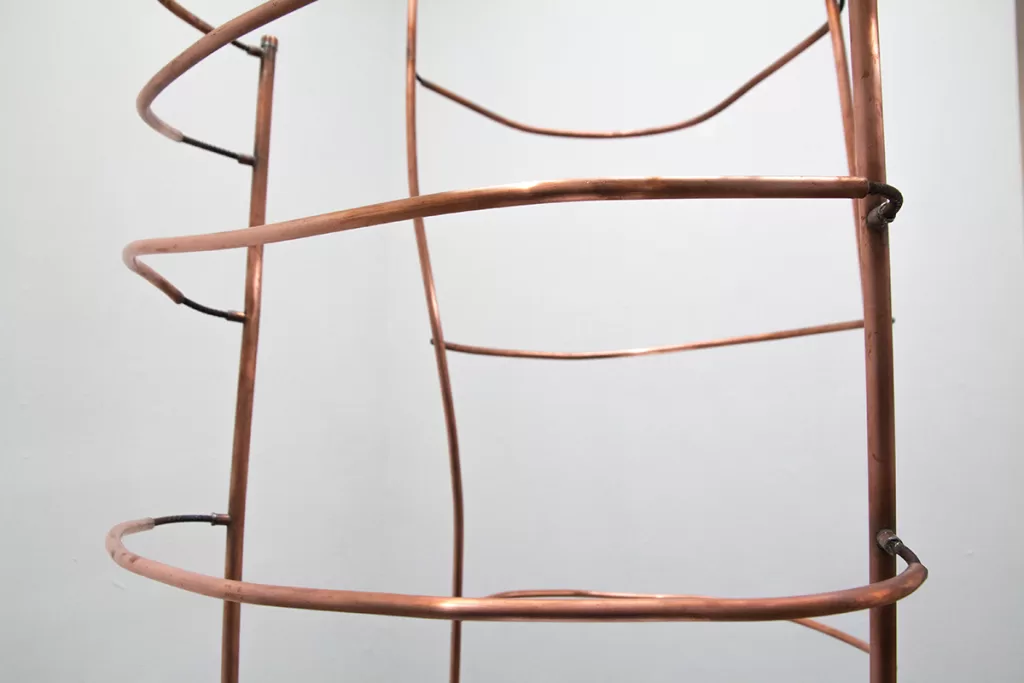En el centro de la exposición encontramos dos cuerpos de cobre, que contienen la métrica, el ritmo de las matemáticas. Con barras, marcas, o peldaños horizontales que dividen la verticalidad de las esculturas en 7 espacios. Estos dos cuerpos enfrentados, se presentan como estructuras blandas, como partes de una caja torácica o radiadores que se dan calor mutuamente. Los tubos de cobre van por dentro de las paredes, bajo el suelo, entre plantas, por las carreteras, y conducen la energía, el calor, el agua, la corriente, el gas, el vapor...
En la obra de Alexa Grande existen temáticas recurrentes como el colapso de las estructuras arquitectónicas, sociales o mentales, que nos contienen y nos sustentan, nos acercan o nos separan. En este sentido, las estructuras de esta exposición responden a la medición del crecimiento, esos números cargados de significados; los años, la edad.
Si cada momento de edades reflejada es un todo (un bloque, un pastel, una pizza) la relación proporcional entre sus edades, va menguando exponenecialmente a medida que ellas van creciendo. Estos espacios vacíos, espacios intermedios entre renglones son la diferencia o relación de edad entre ellas. La métrica nos hablan de la comparación, la admiración y la confrontación entre ambas vidas. La hija va ganando peso, en una relación cada vez más equilibrada sin poder llegar jamás a igualarse del todo. Este es el momento del Ecuador de la balanza, en el casi equilibrio, en la cifra 36-63.
Mit freundlicher Unterstützung der Behörde für Kultur und Medien der Freien und Hansestadt Hamburg
03 - 30
14 - 41
25 - 52
36 - 63
47 - 74
58 - 85
69 - 96
The Grande Theorem explains a numerical phenomenon that connects two lives: mother and daughter.
This phenomenon shines remarkably seven times when a mirror reflects their ages, and they can look into each other's eyes:
The desperate gaze of need can force the encounter of apparent findings that are nothing more than completely forced and unimportant coincidences. This vain search for something mystical or uplifting, although deceptive, is not always entirely sterile.
In this approach from the magic of numbers to the answer of science, and the beauty in it, the Grande Theorem emerges. It blattantly tries to cover its own simplicity veiling itself on technicalities and transfigurated simbolic calculations, but explains why it happens, when it began, and when it will return, and it compels us to see that the same numbers do not hold the same value in different destinies. Although we can always resort to the saving resource of not understanding.
At the center of the exhibition, we find two copper bodies that contain the metrics, the rhythm of mathematics. With bars, marks, or horizontal steps that divide the verticality of the sculptures into 7 spaces.
These two opposing bodies present themselves as soft structures, like parts of a ribcage or radiators that give each other warmth. The copper pipes run inside the walls, under the floor, between floors, through the roads, and conduct energy, heat, water, current, gas, steam...
In Alexa Grande's work, we often find recurring themes, such as architectural, social, or mental structures that contain and sustain us, bringing us closer and separating us.
In this work, the structures respond to the measurement of growth, those numbers laden with meaning: the years, age.
If each moment of reflected ages is a whole (a block, a cake, a pizza), the proportional relationship between their ages decreases exponentially as they grow. These empty spaces, intermediate spaces between rows, are the age difference or relationship between them.
The metrics speak to us of comparison, admiration, and confrontation between both lives. The daughter gains weight in a relationship that becomes more balanced but can never completely equalize.
This is the moment of the balance's equator, in the almost equilibrium, in the figure 36-63




